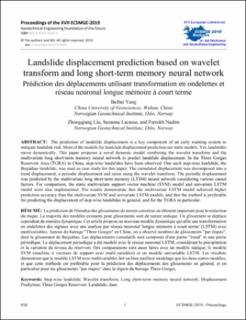Landslide displacement prediction based on wavelet transform and long short-term memory neural network
Chapter
Published version
Permanent lenke
https://hdl.handle.net/11250/2647496Utgivelsesdato
2019Metadata
Vis full innførselSamlinger
- NGI articles [1037]
Originalversjon
Proceedings of the XVII ECSMGE 2019 : Geotechnical Engineering foundation of the future : European Conference on Soil Mechanics and Geotechnical EngineeringSammendrag
The prediction of landslide displacement is a key component of an early warning system to mitigate landslide risk. Most of the models for landslide displacement prediction are static models. Yet, landslides move dynamically. This paper proposes a novel dynamic model combining the wavelet transform and the multivariate long short-term memory neural network to predict landslide displacement. In the Three Gorges Reservoir Area (TGRA) in China, step-wise landslides have been observed. One such step-wise landslide, the Baijiabao landslide, was used as case study for this paper. The cumulated displacement was decomposed into a trend displacement, a periodic displacement and noise using the wavelet transform. The periodic displacement was predicted by the multivariate long short-term memory (LTSM) neural network considering various causal factors. For comparison, the static multivariate support vector machine (SVM) model and univariate LSTM model were also implemented. The results demonstrate that the multivariate LSTM model achieved higher prediction accuracy than the multivariate SVM and univariate LSTM models, and that the method is preferable for predicting the displacement of step-wise landslides in general, and for the TGRA in particular.
